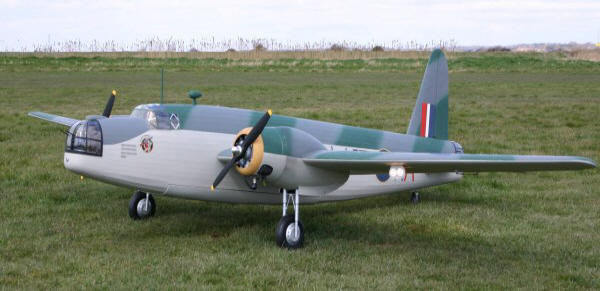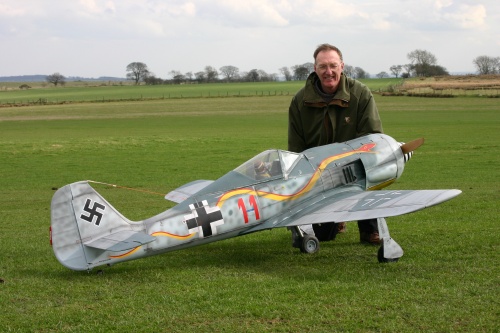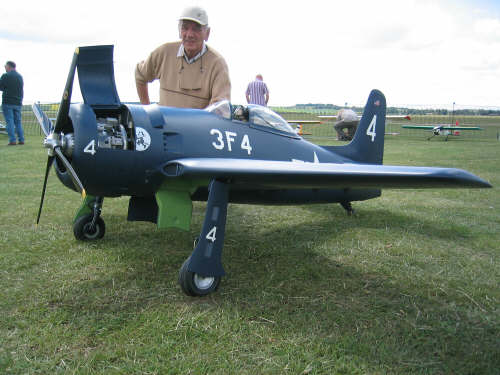This page contains pictures of models of WWII aircraft seen at LMA events.


The Harrow made its maiden flight on the 10th October 1936 from Radlett airfield. In January the following year 214 Squadron based at Scampton took delivery of the first aircraft.
The Harrow was the first production aircraft by Handley Page to have a monoplane construction. It was powered by a pair of Pegasus X engines giving it a maximum speed of 200 mph. A total of 100 aircraft were constructed, 19 x Mk1 and 81 x Mk 2. The Harrow was the first RAF aircraft to feature dark earth/dark green/black camouflage colours. It was also the last aircraft operated by the RAF to have a fixed undercarriage. The nose and tail turrets on the aircraft were fixed due to a shortage of rotating turrets at the time, with a rotating ring at the bottom of the turret for the direction of the gun.
The aircraft soon became dated with the arrival of the Wellington etc., so it became relegated to transport duties. Some aircraft had their nose and tail turrets removed and renamed Sparrows.
MODEL DETAILS:

Here is a photograph of Tony Nijhuis’ latest model. The design of this Wellington started off when Tony Hooper asked if I would design him a 21′ version (similar size to Andy Johnson’s). I thought it may be a good idea to make a smaller 13′ version just for testing purposes plus I have always loved the Wellington. Some 20 years ago, I designed an electric Wellington plan for Model World so I was just about due to build another one. The plan was to make the 13′ Welly electric but there didn’t seem to be any suitable motors on the market to give me a sensible power to weight ratio. Unfortunately, I had built it to 90% complete before I realised electric was not going to be right option. So the last 10% saw conversion to Z26’s and beefing up the airframe in places. The model was drawn in Autocad at 21′ so I hit the re-scale button to 13′ and emailed the parts to SLEC Ltd where within a couple of weeks, the parts were cut and returned…that was back in October 2005. The target weight was to be under 20kg scheme and this proved very easy with this model coming out at 37lb. However, I did install duplicated RX’s and batteries (which really helped to balance the model). The model is fitted with bomb opening doors, retractable landing lights and is detailed ‘loosely’ on Coastal Command colours. The retracts/oleos were made to measure by Tony Goodyer of Unitracts, with Len Gardner 7″ wheels. The model is a real delight to fly and is really overpowered with the Z26, it flies on quarter throttle and any one thinking of a first scale twin will not be disappointed…….CNC packs will be available from SLEC Ltd

Ted Alison with his newly completed Hornet. (February 2006)

Thanks to Mike Szysler for sending me this photograph of Steve Foxon’s Beech. Model was built form a Nick Zeroli plan. (September 2005)

Mike Booth sent this photo of Jon Horne’s Spitfire built from an original Flying Legends Kit. 4.8 scale, 90″ span 3W 40 power, Unitracts gear. The model is now 10 years old does not look any different to the day it rolled of the bench. The MK 9 MH434 replica has been maintained meticulously throughout its hundreds of sorties at LMA shows. It is also testimate to the fact that careful preparation superb piloting and “the right approach” can mean a model will have along and happy life.

Colin Auton here with his 25% scale FW190. The model weighs 40lb and is powered by a DA100. At the time of this photograph the model had completed two flights.

A unique model was brought over from the Netherlands for Duxford 2004. It features a home built engine with a true variable pitch, constant speed, propeller. This has been attempted by other modellers, but here we had a fantastic example of engineering masterwork.
For event tickets, merchandise and more visit our online shop.